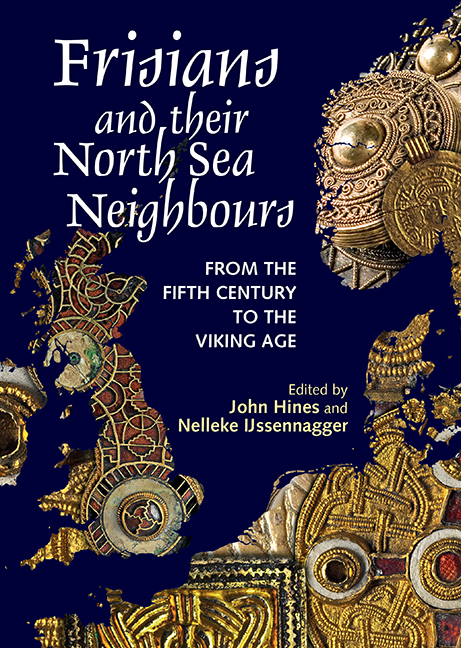Book contents
- Frontmatter
- Contents
- List of Figures
- List of Tables
- Preface
- Acknowledgements
- Linguistic Conventions and Abbreviations
- Abstracts
- Introduction: Frisians – Who, When, Where, Why?
- 1 Palaeogeography and People: Historical Frisians in an archaeological light
- 2 The Anglo-Frisian Question
- 3 Frisian between the Roman and the Early Medieval Periods: Language contact, Celts and Romans
- 4 ‘All quiet on the Western Front?’ The Western Netherlands and the ‘North Sea Culture’ in the Migration Period
- 5 Power and Identity in the Southern North Sea Area: The Migration and Merovingian Periods
- 6 How ‘English’ is the Early Frisian Runic Corpus? The evidence of sounds and forms
- 7 The Geography and Dialects of Old Saxon: River-basin communication networks and the distributional patterns of North Sea Germanic features in Old Saxon
- 8 Between Sievern and Gudendorf: Enclosed sites in the north-western Elbe–Weser triangle and their significance in respect of society, communication and migration during the Roman Iron Age and Migration Period
- 9 Cultural Convergence in a Maritime Context: Language and material culture as parallel phenomena in the early-medieval southern North Sea region
- 10 The Kingdom of East Anglia, Frisia and Continental Connections, c. ad 600–900
- 11 A Comparison of the Injury Tariffs in the Early Kentish and the Frisian Law Codes
- 12 Cultural Contacts between the Western Baltic, the North Sea Region and Scandinavia: Attributing runic finds to runic traditions and corpora of the Early Viking Age
- Index
5 - Power and Identity in the Southern North Sea Area: The Migration and Merovingian Periods
Published online by Cambridge University Press: 25 August 2018
- Frontmatter
- Contents
- List of Figures
- List of Tables
- Preface
- Acknowledgements
- Linguistic Conventions and Abbreviations
- Abstracts
- Introduction: Frisians – Who, When, Where, Why?
- 1 Palaeogeography and People: Historical Frisians in an archaeological light
- 2 The Anglo-Frisian Question
- 3 Frisian between the Roman and the Early Medieval Periods: Language contact, Celts and Romans
- 4 ‘All quiet on the Western Front?’ The Western Netherlands and the ‘North Sea Culture’ in the Migration Period
- 5 Power and Identity in the Southern North Sea Area: The Migration and Merovingian Periods
- 6 How ‘English’ is the Early Frisian Runic Corpus? The evidence of sounds and forms
- 7 The Geography and Dialects of Old Saxon: River-basin communication networks and the distributional patterns of North Sea Germanic features in Old Saxon
- 8 Between Sievern and Gudendorf: Enclosed sites in the north-western Elbe–Weser triangle and their significance in respect of society, communication and migration during the Roman Iron Age and Migration Period
- 9 Cultural Convergence in a Maritime Context: Language and material culture as parallel phenomena in the early-medieval southern North Sea region
- 10 The Kingdom of East Anglia, Frisia and Continental Connections, c. ad 600–900
- 11 A Comparison of the Injury Tariffs in the Early Kentish and the Frisian Law Codes
- 12 Cultural Contacts between the Western Baltic, the North Sea Region and Scandinavia: Attributing runic finds to runic traditions and corpora of the Early Viking Age
- Index
Summary
The southern North Sea area of the 5th to 7th centuries ad can be seen as an important ‘cultural bridge’ linking two power blocks: the late Roman Empire and its Frankish successor kingdom to the south, and the Scandinavian kingdoms to the north. This paper discusses how such a bridge function is reflected in the material culture found along the southern North Sea coasts of the Netherlands, Germany and south-eastern England, and how this material culture relates to the rise of kingdoms and the expression of group identities. The discussion will focus on jewellery and other ornaments of gold and silver, which can be assigned to five ‘cultural phases’ (Nicolay 2014, 234–63). First, the cultural relations with surrounding areas, as reflected in the ornaments’ shape and decoration, will be examined for each phase. Second, an attempt will be made to link the geographical distribution of ornaments that were executed in a specific style to the expression of group identity at a regional or supra-regional level – as a reflection of the extent of specific elite networks, which are assumed to represent the territories of early-medieval kingdoms.
The premise for this analysis is the assumption that access to gold and silver in earlymedieval Europe was limited to a small group of people. It was regional or supra-regional kings who controlled the importation of these precious metals, which probably reached the North Sea world both as political gifts and through a more commercial form of longdistance exchange (for the latter, see Näsman 1991). Besides these ‘horizontal’ relations among leaders, networks of ‘vertical’ relations were established and consolidated by the distribution of valuable items as gifts between leaders (the patrons) and their followers (the clients) (Bazelmans 1999). As members of the royal and lower retinues would have their own groups of followers, this resulted in the well-known pyramidal structure of patron–client relations, in which a person's status was directly related to his or her ‘distance from the king’.
Gold and silver were exchanged not only as gifts, but probably also as a form of currency between members of the elite and their followers – as indicated by the frequent occurrence of gold coins not transformed into jewellery.
- Type
- Chapter
- Information
- Frisians and their North Sea NeighboursFrom the Fifth Century to the Viking Age, pp. 75 - 92Publisher: Boydell & BrewerPrint publication year: 2017

